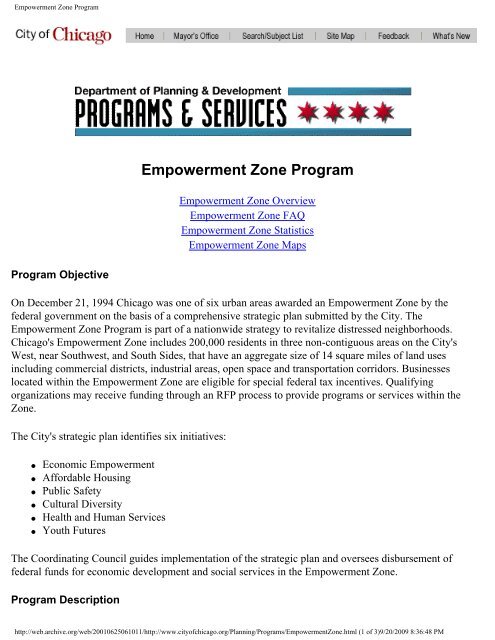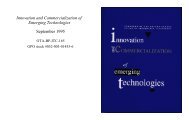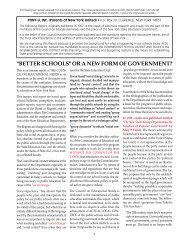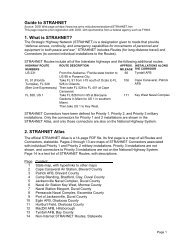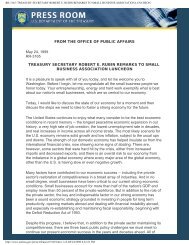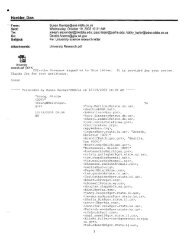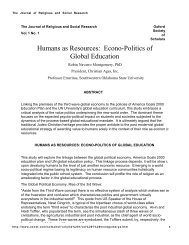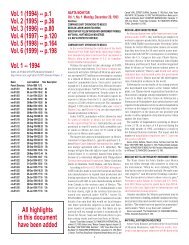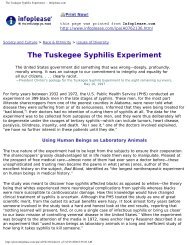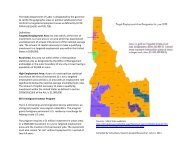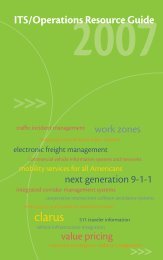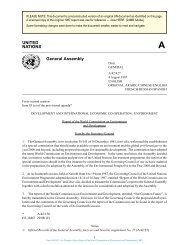Empowerment Zone Program - Channeling Reality
Empowerment Zone Program - Channeling Reality
Empowerment Zone Program - Channeling Reality
You also want an ePaper? Increase the reach of your titles
YUMPU automatically turns print PDFs into web optimized ePapers that Google loves.
<strong>Empowerment</strong> <strong>Zone</strong> <strong>Program</strong><strong>Empowerment</strong> <strong>Zone</strong> <strong>Program</strong><strong>Empowerment</strong> <strong>Zone</strong> Overview<strong>Empowerment</strong> <strong>Zone</strong> FAQ<strong>Empowerment</strong> <strong>Zone</strong> Statistics<strong>Empowerment</strong> <strong>Zone</strong> Maps<strong>Program</strong> ObjectiveOn December 21, 1994 Chicago was one of six urban areas awarded an <strong>Empowerment</strong> <strong>Zone</strong> by thefederal government on the basis of a comprehensive strategic plan submitted by the City. The<strong>Empowerment</strong> <strong>Zone</strong> <strong>Program</strong> is part of a nationwide strategy to revitalize distressed neighborhoods.Chicago's <strong>Empowerment</strong> <strong>Zone</strong> includes 200,000 residents in three non-contiguous areas on the City'sWest, near Southwest, and South Sides, that have an aggregate size of 14 square miles of land usesincluding commercial districts, industrial areas, open space and transportation corridors. Businesseslocated within the <strong>Empowerment</strong> <strong>Zone</strong> are eligible for special federal tax incentives. Qualifyingorganizations may receive funding through an RFP process to provide programs or services within the<strong>Zone</strong>.The City's strategic plan identifies six initiatives:●●●●●●Economic <strong>Empowerment</strong>Affordable HousingPublic SafetyCultural DiversityHealth and Human ServicesYouth FuturesThe Coordinating Council guides implementation of the strategic plan and oversees disbursement offederal funds for economic development and social services in the <strong>Empowerment</strong> <strong>Zone</strong>.<strong>Program</strong> Descriptionhttp://web.archive.org/web/20010625061011/http://www.cityofchicago.org/Planning/<strong>Program</strong>s/<strong>Empowerment</strong><strong>Zone</strong>.html (1 of 3)9/20/2009 8:36:48 PM
<strong>Empowerment</strong> <strong>Zone</strong> <strong>Program</strong>The <strong>Empowerment</strong> <strong>Zone</strong> program established special tax incentives for qualified businesses, designed tostimulate private investment and create jobs within the community. These incentives, which have anestimated aggregate value of approximately $225 million over the 10 year life of the program mayinclude:●●●●Employer wage credits of up to $3,000 for wages and certain training expenses paid on behalf of aqualified zone resident that works within an <strong>Empowerment</strong> <strong>Zone</strong>.Tax deductions of up to $37,500 of the cost to certain zone property.Tax-exempt bond financing for businesses seeking to expand within the zone.Employer wage credits up to $2100 for hiring "high-risk youth" who reside in <strong>Empowerment</strong><strong>Zone</strong>s (EZ) or Enterprise Communities (EC).<strong>Empowerment</strong> <strong>Zone</strong> businesses that are located in one of Chicago's State of Illinois-designated Enterprise<strong>Zone</strong>s may be eligible for additional benefits, including property, sales and income tax relief.Chicago also submitted applications for three Enterprise Communities: Calumet, Englewood and a portionof the West Side.<strong>Program</strong> Qualifications/Restrictions and ParametersThe Department of Planning and Development and the Coordinating Council review all requests forfunding and ensure compliance with federal, state and city program guidelines.West ClusterPilsen/Little Village ClusterSouth Clusterhttp://web.archive.org/web/20010625061011/http://www.cityofchicago.org/Planning/<strong>Program</strong>s/<strong>Empowerment</strong><strong>Zone</strong>.html (2 of 3)9/20/2009 8:36:48 PM
<strong>Empowerment</strong> <strong>Zone</strong> <strong>Program</strong><strong>Program</strong> ContactDepartment of Planning and Development<strong>Empowerment</strong> <strong>Zone</strong> Division20 North Clark, 28th FloorChicago, IL 60602(312) 744-CITY<strong>Program</strong>s & Services | DPD Home | Contact DPD | Email DPD© City of Chicago, 1998http://web.archive.org/web/20010625061011/http://www.cityofchicago.org/Planning/<strong>Program</strong>s/<strong>Empowerment</strong><strong>Zone</strong>.html (3 of 3)9/20/2009 8:36:48 PM
<strong>Empowerment</strong> <strong>Zone</strong> OverviewThe Chicago <strong>Empowerment</strong> <strong>Zone</strong> - An OverviewChicago's nominated <strong>Empowerment</strong> <strong>Zone</strong> consists of three non-contiguous areas: the West Cluster, thePilsen/Little Village Cluster and the South Cluster. These clusters include distressed and impoverishedcommunities. Each cluster contains neighborhoods, industrial zones and physical assets that defines itscharacter and provides opportunities to address physical, human, social and economic needs.The Residents of the <strong>Zone</strong>Chicago's <strong>Empowerment</strong> <strong>Zone</strong> includes 199,938 residents living in a 14.3 square mile area. Thepopulation density of the <strong>Zone</strong> is 13,953 persons per square mile compared with Chicago's overall densityof 12,184 persons per square mile. Within the three geographic clusters, however, population densityranges considerably from a low of 10,632 persons per square mile in the West Cluster, to 20,236 personsper square mile in the Pilsen/Little Village Cluster. The racial composition of the <strong>Zone</strong> is 71.5% African-American, 24.3% Latino, 3.8% white, and 0.4% other.Physical CharacterThe physical character of the three geographic clusters reflects Chicago's historical development. Thedensities are typical of mature urban areas. The geographic clusters contain a full range of land usesincluding residential neighborhoods, commercial districts, industrial areas, parks and open space, andtransportation corridors.Residential communities developed around jobs and transportation systems that provide access to jobs.The West and Pilsen/Little Village Clusters developed around industry. Commercial corridors later grewup to meet the needs of local residents. Within the South Cluster the neighborhoods located around theUnion stockyards developed in the same fashion. Most of the economic base of the South Clusterdeveloped to serve the needs of the densely populated black community which has called this area homesince the 1890's.Strong industrial corridors along rail lines and the Chicago River define and separate residentialneighborhoods. These neighborhoods are close to Chicago's Loop and feature many large parks of theChicago park system.http://web.archive.org/web/20010217191739/www.cityofc...lanning/<strong>Program</strong>s/<strong>Empowerment</strong><strong>Zone</strong>/Emp<strong>Zone</strong>Overview.html (1 of 3)9/20/2009 8:38:08 PM
<strong>Empowerment</strong> <strong>Zone</strong> Overview<strong>Zone</strong> AssetsAlthough the <strong>Empowerment</strong> <strong>Zone</strong> communities have lost much of their historic strength over the last fewdecades, they still possess strong assets on which to build a bright future. These assets include atransportation network that is unparalleled in the nation, first-rate hospitals, colleges and universities,sports and cultural facilities that attract hundreds of thousands each year, park and recreational facilities,abundant industrially and commercially zoned land upon which to build economic strength, andcommitted residents and community-based organizations with historic involvement in their communities.The <strong>Empowerment</strong> <strong>Zone</strong> communities are served by three major expressways: the Dan Ryan, theStevenson and the Eisenhower linking the <strong>Zone</strong> with the rest of the metropolitan area. The ChicagoTransit Authority (CTA)'s rapid transit lines date from the 1890's and link the <strong>Zone</strong> to the rest of Chicagoand adjacent suburbs. Metra commuter rail lines provide additional transit links to Chicago's Loop,suburban communities and the rest of the nation. The $300 million renovation of the CTA's "Green Line",completed in 1995, represents a strong local commitment to maintaining transit access for even Chicago'smost impoverished neighborhoods.The University of Chicago, the Illinois Institute of Technology, Northeastern Illinois University's Centerfor Inner-City Studies and The University of Illinois at Chicago are all located near the <strong>Empowerment</strong><strong>Zone</strong> communities. These institutions have traditionally provided technical assistance and support to manycommunity groups active in <strong>Empowerment</strong> <strong>Zone</strong> neighborhoods. Two of Chicago's City Colleges----Malcolm X and Kennedy-King----provide vocational training and education for area residents.The hospitals and medical schools in an around the <strong>Empowerment</strong> <strong>Zone</strong> are strong resource anchors.More than a dozen hospitals range from facilities that primarily serve the needs of neighborhood residentsto world class teaching hospitals, and include: Michael Reese/Humana, Sacred Heart, NorwegianAmerican, St. Elizabeth's, St. Mary of Nazareth, Loreto, Bethany, the Westside VA, Cook County, RushPresbyterian-St. Luke's Medical Center, St. Cabrini, the University of Illinois, Mt. Sinai, St. Anthony,Provident, and La Rabida Children's Hospital. These facilities are most strongly concentrated in andaround the West Cluster.The Museum of Science and Industry, the DuSable Museum, the Mexican Fine Arts Museum and theGarfield Park Conservatory are cultural assets that draw visitors from other parts of the Chicago region.Among the key trademarks of Chicago are its boulevards, its lakefront park system and its largecommunity parks, a legacy left by planning giants like Daniel Burnham. These open space resources arephysical amenities that can be enhanced to help rebuild attractive and desirable residential neighborhoods.The Chicago Park District is in the process of reassessing its service delivery and working to meet theneeds of the community. It has an established capital improvement program designed to upgrade parksand recreational facilities. Garfield Park, the Garfield Park Garden for the Blind, and the Garfield ParkConservatory are located in the West Cluster. The Garfield Park Conservatory is the world's largestenclosed conservatory, covering 4.5 acres with over 5,000 varieties of plants, flowers and trees. BurnhamPark forms an eastern edge of the South Cluster and is an important link in Chicago's lakefront parkhttp://web.archive.org/web/20010217191739/www.cityofc...lanning/<strong>Program</strong>s/<strong>Empowerment</strong><strong>Zone</strong>/Emp<strong>Zone</strong>Overview.html (2 of 3)9/20/2009 8:38:08 PM
<strong>Empowerment</strong> <strong>Zone</strong> Overviewsystem. Harrison Park serves the Pilsen/Little Village Cluster. In addition to these recreation and openspace amenities, several other large parks including Washington Park, Jackson Park and the South ShoreCountry Club are located immediately adjacent to the <strong>Empowerment</strong> <strong>Zone</strong>.Major industrial corridors are located along the rail lines and the South branch of the Chicago River. TheState has designated state enterprise zones, portions of which are located in the nominated <strong>Empowerment</strong><strong>Zone</strong> and made other incentives available through the State's tax increment financing and Industrial JobsRecovery Act legislation. The City has successfully used these tools and others to attract and retainindustrial users who provide jobs for Chicago residents and an enhanced tax base that can support muchneeded physical improvements.Chicago was developed on a grid system with commercial and retail streets located at regular intervals.There are many existing commercial corridors in the <strong>Empowerment</strong> <strong>Zone</strong> where retail activity still thrives.The newly constructed Chicago Transit Authority (CTA) Green Line links the three geographic areas ofthe <strong>Empowerment</strong> <strong>Zone</strong> together. It offers a unique opportunity to link redevelopment of the commercialcorridors of the <strong>Zone</strong> with the reconstruction and development of new transit stops.Local residents and community activists and planners are involved in neighborhood improvement and landplanning initiatives. Block clubs and tenant councils are common throughout the area. Severalcommunities have initiated, facilitated and established City-sanctioned plans for redevelopment andrevitalization.© City of Chicago, 1998http://web.archive.org/web/20010217191739/www.cityofc...lanning/<strong>Program</strong>s/<strong>Empowerment</strong><strong>Zone</strong>/Emp<strong>Zone</strong>Overview.html (3 of 3)9/20/2009 8:38:08 PM
<strong>Empowerment</strong> <strong>Zone</strong> FAQ<strong>Empowerment</strong> <strong>Zone</strong> FAQFrequently Asked Questions About Chicago's EZ/EC <strong>Program</strong>1. What is the <strong>Empowerment</strong> <strong>Zone</strong>/Enterprise Community <strong>Program</strong>?2. Where is Chicago's <strong>Empowerment</strong> <strong>Zone</strong> located?3. What does <strong>Zone</strong> status bring to these communities?4. What other resources are available to EZ/EC communities?5. How are EZ funds allocated?6. Have any EZ funds been allocated?7. When will the next RFP be released?8. Where can I get more information about Chicago's <strong>Empowerment</strong> <strong>Zone</strong>/Enterprise Communityprogram?1. What is the <strong>Empowerment</strong> <strong>Zone</strong>/Enterprise Community <strong>Program</strong>?The <strong>Empowerment</strong> <strong>Zone</strong>/Enterprise Community (EZ/EC) program was established in the Fall of1993 under the Federal Omnibus Budget Reconciliation Act and is the capstone of the ClintonAdministration community revitalization strategy. The program is designed to empower people andcommunities across the United States by inspiring Americans to work together to develop astrategic plan designed to create jobs and opportunities in our nation's most impoverished urbanand rural areas.Through the U.S. Department of Housing and Urban Development (HUD) a nation widecompetition for the designation of six urban EZs and sixty-five urban ECs began in January of1994. Each designated <strong>Empowerment</strong> <strong>Zone</strong> and Enterprise community would be awarded federalgrant funds along with various tax benefits for EZ-based businesses.Interested EZ or EC applicants were required to prepare a community-based strategic plan forrevitalization----the cornerstone of the application process for <strong>Empowerment</strong> <strong>Zone</strong> or Enterprisehttp://web.archive.org/web/20010711084830/www.cityofc...org/Planning/<strong>Program</strong>s/<strong>Empowerment</strong><strong>Zone</strong>/Emp<strong>Zone</strong>FAQ.html (1 of 3)9/20/2009 8:38:52 PM
<strong>Empowerment</strong> <strong>Zone</strong> FAQCommunities. The Strategic Plan required communities to asses their assets and problems, create avision of a better future, and structure a plan for achieving that vision.On December 21, 1994, due in large part to Chicago's unique collaboration of over 200governmental agencies, community groups, businesses and institutions, the City was awarded oneof only six urban <strong>Empowerment</strong> <strong>Zone</strong>s.Chicago submitted three Enterprise Community applications for Calumet, Englewood, and theWest Side. Chicago did not receive any designations for Enterprise Community status. However,the City of Chicago and State of Illinois have committed to work toward implementation of thestrategic plans developed through this process.2. Where is Chicago's <strong>Empowerment</strong> <strong>Zone</strong> located?Chicago's <strong>Empowerment</strong> <strong>Zone</strong> comprises three non-contiguous "cluster" areas located on the West,Lower West (Pilsen/Little Village), and near South Sides. As a whole, the <strong>Empowerment</strong> <strong>Zone</strong>covers 14.3 square miles and includes 199,938 residents. The EZ contains a full range of land uses,including residential neighborhoods, commercial districts, industrial areas, parks, open space, andtransportation corridors..3. What does <strong>Zone</strong> status bring to these communities?Each designated <strong>Empowerment</strong> <strong>Zone</strong> was awarded $100 million in EZ Social Service Block Grant(SSBG) funds to be used to implement the strategic plan. Designated EZs also receive priorityconsideration for federal programs and direct assistance from federal officials to facilitateimplementation of the EZ Strategic Plan.In addition, special tax incentives designed to stimulate private investment and job creation in thezone are available to qualified businesses. These incentives, which average an estimated aggregatevalue of approximately $250 million over a 10-year period, include:❍❍❍❍❍employer wage credit of up to $3,000 for wages and certain training expenses paid onbehalf of a qualified zone resident;deduction (instead of depreciation) of up to 37,500 of the cost of certain qualified zoneproperty in the year it is placed in service;new tax-exempt facility bond financing;priority consideration for other federal grants; andconsideration for waiver from federal regulations.4. What other resources are available to EZ/EC communities?The State of Illinois has made a $37 million commitment to Chicago's <strong>Empowerment</strong> <strong>Zone</strong> andEnterprise Communities over the ten-year life of the program. The City of Chicago has also madehttp://web.archive.org/web/20010711084830/www.cityofc...org/Planning/<strong>Program</strong>s/<strong>Empowerment</strong><strong>Zone</strong>/Emp<strong>Zone</strong>FAQ.html (2 of 3)9/20/2009 8:38:52 PM
<strong>Empowerment</strong> <strong>Zone</strong> FAQfinancial commitments including a $2 million appropriation in its 1995 budget, the use of generalobligation bond proceeds, Job Training Partnership Act (JTPA) and Community DevelopmentBlock Grant (CDBG) funding, and tax increment financing. The private sector has also committedto invest over $2 billion in <strong>Empowerment</strong> <strong>Zone</strong> and Enterprise Community areas.5. How are EZ funds allocated?The $100 million of SSBG funds originate from the U.S. Department of Health and HumanServices (HHS) and pass through the State of Illinois Department of Public Aid to the City ofChicago for use by the EZ. All requests for funding must go through the <strong>Empowerment</strong> <strong>Zone</strong>/Enterprise Community Coordinating Council (EZ/EC CC), the governing entity of the Chicago<strong>Empowerment</strong> <strong>Zone</strong>. Recommendations for funding from the EZ/EC CC are then forwarded to theChicago City Council for final approval.6. Have any EZ funds been allocated?A Request for Proposals (RFP) was released in October of 1995 to select programs and providersto implement Chicago's strategic plan. By the December 18, 1995 deadline, approximately 250proposals had responded to this request.This first RFP process reached its conclusion in February of 1997. A total of 84 projects have beenfunded, allocating approximately $43 million in EZ Social Service Block Grant, State and Citycommitted funds.7. When will the next RFP be released?The next RFP is scheduled for release in the Summer of 1997.8. Where can I get more information about Chicago's <strong>Empowerment</strong> <strong>Zone</strong>/EnterpriseCommunity program?Anyone interested in receiving general information about Chicago's <strong>Empowerment</strong> <strong>Zone</strong> cancontact the City of Chicago's <strong>Empowerment</strong> <strong>Zone</strong> office at (312) 744-8420. To learn more aboutChicago <strong>Empowerment</strong> <strong>Zone</strong> benefits for businesses, please contact Ray Adams, Director ofBusiness Development, at (312) 744-9466.© City of Chicago, 1998http://web.archive.org/web/20010711084830/www.cityofc...org/Planning/<strong>Program</strong>s/<strong>Empowerment</strong><strong>Zone</strong>/Emp<strong>Zone</strong>FAQ.html (3 of 3)9/20/2009 8:38:52 PM
Chicago Fact Book: <strong>Empowerment</strong> <strong>Zone</strong>sEZ/EC Characteristics | Business | GeographyPublic Facilities | Development <strong>Program</strong> OpportunitiesReturn to IndexOn December 21, 1994, the City of Chicago was designated as one of six urban <strong>Empowerment</strong> <strong>Zone</strong>s(EZ) by the U.S. Department of Housing and Urban Development (HUD).The three non-contiguouscommunities that make up Chicago's EZ are the near West Side, Pilsen/Little Village and the near SouthSide. Federal benefits for a designated EZ are: $100 million in Social Service Block Grant (SSBG)funding, tax credits to businesses located in the EZ employing residents of the EZ, accelerateddepreciation for capital equipment purchases for EZ businesses, consideration for waiver from federalregulation, and new tax-exempt EZ bonds. Priority consideration for federal grants was also part of the EZdesignation.Although Chicago did not receive any designations for Enterprise Community (EC) status, the City andState have recognized the City's three non-designated EC communities (Englewood, Calumet and theremainder of the West Side) as part of the EZ process. Moreover, part of the State's $50 millioncommitment over the next 10 years to all Illinois EZ and EC applicants will be made available to thesecommunities.Employer wage tax credits of up to $3,000 per zone resident employed are available to businesses locatedwithin the targeted area. These credits can be claimed for wages paid to the employee as well as forcertain training expenses. Businesses in the zone can also expand and create jobs using tax-exempt bondfinancing of up to $3 million.EZ/EC Population CharacteristicsEZEChttp://web.archive.org/web/20010618004359/www.cityofchicago.org/Planning/ChgoFacts/Emp<strong>Zone</strong>.html (1 of 3)9/20/2009 8:40:29 PM
Chicago Fact Book: <strong>Empowerment</strong> <strong>Zone</strong>sTotal persons 199,938 256,363Total Families 42,413 55,200RaceCaucasian 7,547 8,186African-American 142,994 212,741Native American 201 233Asian-American 362 1,953Latino 48,663 33,012EZ/EC Labor Force CharacteristicsPersons 16 & Over 133,539 174,803Labor Force 66,812 93,239Unemployed 16,413 23,221Employed 50,253 69,824Source: 1990 Census of Population and Housing, Bureau of the Census, U.S. Department of Commerce.BusinessesGeographyPublic FacilitiesEstimated Number 4,315 4,318of BusinessesCensus Tracts 96 107Area (Sq Miles) 14.33 27.13Libraries 7 8Public Schools 76 112Parks (Acres) 1,601 698Park Facilities 64 59Health and Human ServiceFacilities 11 11http://web.archive.org/web/20010618004359/www.cityofchicago.org/Planning/ChgoFacts/Emp<strong>Zone</strong>.html (2 of 3)9/20/2009 8:40:29 PM
Chicago Fact Book: <strong>Empowerment</strong> <strong>Zone</strong>sDevelopment <strong>Program</strong> Opportunities in the EZ/EC●●●●●●●●●●Brownfields InitiativeCommercial DistrictConservation AreaInnovative Project InitiativeModel Industrial CorridorRedevelopment Area <strong>Program</strong>Special Service AreaStrategic Neighborhood Action <strong>Program</strong>State Enterprise <strong>Zone</strong>Tax Increment Financing District« Previous Index Next »Copyright 1999 by the City of Chicagohttp://web.archive.org/web/20010618004359/www.cityofchicago.org/Planning/ChgoFacts/Emp<strong>Zone</strong>.html (3 of 3)9/20/2009 8:40:29 PM


